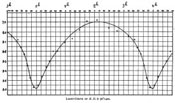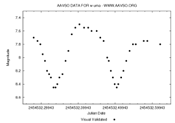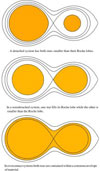W Ursae Majoris Discovered
 |
| The discovery light curve of W UMa (Muller and Kempf 1903). Click to enlarge. |
The variability of W UMa was first noted in the early 1900s by Muller and Kempf (1903) during zone observations for the Potsdam Photometric Durchmusterung. The star apparently exhibited an extraordinarily short period of only about four hours -- the shortest known period to that date. (The correct period is now known to be twice that, just over eight hours.) While brightness variations were evident in the light curve, the type, however, could not be placed amongst the known classes of the time. To explain the variability, the authors proposed variations due to a rotating body with a surface of unequal brightness distribution, which could be a result of an advanced age of cooling. Alternatively, the object could be a figure deviating from spherical shape to something more of an ellipsoid. More likely, however, Muller and Kempf suggested that the variable might be two bodies, nearly equal in size and luminosity, with surfaces relatively close in distance that occult each other during the course of revolution. Thereafter, W UMa's classification wavered from such types as an eclipsing binary, a Cepheid, or a cluster-type variable. W UMa's status as an eclipsing binary was finally settled, and detailed parameters for the star were published by Adams and Joy (1919). Discoveries of similar stars followed when Schilt (1926) reported on two new variables of the W UMa type: i Bootis and BD+75 752. Now, a century later, there are over 7,000 W UMa type stars listed in the Variable Star Index (VSX)!
Characteristics of the W UMa Stars
 |
| The eclipses of W UMa. Click to enlarge. |
W UMa stars are easily recognized by their light curves with near equal minima and continuous light variation. Variability ranges from a few tenths to slightly over a magnitude. The periods are typically short and range between 0.25 days to around 1.0 days. Each of the components in the binary are of nearly the same spectral type, from around middle A to early K, with the bulk concentrated in middle F through early G. The stars are assumed to be in a similar evolutionary state, located near or just above the main sequence. The components are of different mass, but share very similar temperatures. The stars in the W UMa systems are believed to be very close together, even touching. Thus, they are categorized as near or overcontact systems. Each star in the binary has the same surface temperature despite having different masses because they share a common envelope; the stars are in thermal contact, and heat flows from the more massive star to the less massive one.
Nature and Evolution
 |
| Diagram of the detached, semi-detached, and overcontact systems (Terrell 2001). Click to enlarge. |
Although W UMa stars are thought of as contact binaries, a satisfactory theory for origin, structure, and evolution of the class is not complete. The traditional theory explaining the origin of contact binaries is that W UMa systems form from detached binaries of comparable periods through orbital decay by angular momentum loss. The idea of the contact binary seems to have been first introduced by Kuiper (1941) and applied to the early-type eclipsing binary Beta Lyrae. The possibility that the majority of close binary stars of late spectral type, such as the W UMa systems, may be in contact emerged from the analysis of Kopal (1955). The term, "contact binary," however, seems to have had had slightly different meanings to Kuiper and to Kopal. A history of the term is presented in Wilson (2001).
Although there was some suspicion that W UMa stars were not contact systems (Wood 1969), the contact binary model is the generally accepted view. The pair are two main sequence stars of different masses in physical contact, with mass ratios higher than ten-to-one in some cases (Genet et al. 2005). The surfaces are distorted from a spherical shape in a manner consistent with equipotential surfaces (Kopal 1959). Lucy (1968) was the first to apply the Roche model to eclipsing binary stars - more specifically, it was applied to the W UMa stars. In the short-period, dumb-bell shaped binary, both stars are in contact or overflowing the Roche lobes. As a result, the components share a common envelope. Li et al. (2007) found that most W UMa systems might be formed from detached binaries with periods less than/approximately 2.24 days and a maximum advanced time from a detached system to a W UMa to be about 3.23 Gyr.
Two Groups Proposed
Binnendijk (1970) divided the W UMa binaries into two subclasses based on observational characteristics, referred to as the A- and W-type systems with the division as follow:
A-type class: A-type systems usually possess components with earlier spectral type (typically from A to G), higher luminosity, larger mass, and a smaller mass ratio. The degree of contact is larger and a thick common envelope is present (Van Hamme 1982). Light curves of the A-type systems show the deeper primary minimum due to the transit eclipse of the larger, more massive, hotter component.
W-type class: W-type systems are generally composed of stars of later spectral type (from F to K). In the W-type W UMa stars, the deeper primary minimum corresponds to the occultation eclipse of the smaller, less massive component. Stars in the W-type systems are generally closer to the zero age main sequence (ZAMS) than the A-type class. The secondary components of the W-type systems have radii larger than normal ZAMS of about the same mass.
A- and W-type systems are usually assumed to be in slightly different states of evolution. Some theories suggest the possibility that W-type systems evolve into A-type through mass exchange (Hilditch, King & McFarlane 1988) while others suggest the opposite (Gazeas & Niarchos 2006). Wilson (1978) reported that eight A-type systems with accurately determined parameters all had larger than zero-age main sequence radii, i.e., that they were all evolved.
Period Variation
W UMa has exhibited some slight period changes since its discovery in 1903. One theory to describe this phenomenon is mass transfer between the components of the system, which is viewed to change the period on the basis of angular momentum redistribution (Rucinski 1993). Guinan & Bradstreet (1988) report the presence of large starspots, as well as the strong chromospheric and coronal X-ray emissions typcial of W UMa-type binaries, indicate the presence of a strong, dynamo-related magnetic activity for the system. These intense magnetic fields may very well control the mass flow and magnetic breaking effects responsible for the observed period changes. Whelan, Mochanacki, and Worden (1974) consider three possible causes of period change: (1) mass exchange and/or mass loss; (ii) apsidal motion and (iii) the possibility of a third body. Pribulla and Ruckinski (2006) found that up to 50% of W UMa stars have companions. A complete explanation, however, remains outstanding.
Observing W UMa
AAVSO observers began monitoring W UMa in 1966, logging over 1,600 to date. Ursa Major is a circumpolar constellation for many in the northern hemisphere, so W UMa is a great star to observe virtually any time of the year. According to the AAVSO International Database, W UMa varies between a visual magnitude of about 7.3 to about 8.8, making it a great candidate for binocular observers and those with modest telescopes. Eclipsing binaries should be observed any clear night; every 10 minutes during eclipse, with the date and time recorded as accurately as possible. Observers may find the Eclipsing Binary Ephemerides a helpful tool for planning. Variable star charts may be customized via the Variable Star Plotter and observations may be submitted by one of the procedures listed here.
 |
| "Sunrise in a W UMa system" by Dirk Terrell. Click to enlarge. |
Binary stars, more specifically, eclipsing binary stars, can provide important data about stars, such as mass and radii. Terrell (2006) suggests that newer technologies might help to answer some questions about binary systems, including the detection and analysis of extrasolar planets in binary systems. Also modeling and software improvements, acquiring and analyzing new kinds of observables, and other developments can help answer some of questions about W UMa stars. This, in conjunction with continued visual observations, will provide important clues to these systems.
For further reading
- Adams, W.S., and Joy, A.H., 1919, "The Orbits of Three Spectroscopic Binaries ," The Astrophysical Journal, 49, 186
- Binnendijk, L., 1970, "The Orbital Elements of W Ursae Majoris Systems," Vistas in Astronomy, 12, 217
- Gazeas, K.D., and Niarchos, P.G., 2006, "Masses and Angular Momenta of Contact Binary Stars," Monthly Notices of the Royal Astronomical Society, 370, L29
- Genet, R.M., Thomas, C.S., Terrell, D., Doyle, L., 2005, "Changes in the Light Curves of Short-Period W Ursae Majoris Binaries: Program Summary," Journal of the AAVSO, 34, 54
- Guinan, E.F., and Bradstreet, D.H., 1988, Kinematic Clues to the Origin and Evolution of Low Mass Contact Binaries," in Formation and Evolution of Low Mass Stars, A.K. Dupree and M.T.V.T. Lago (eds), ASI Series, 241, 345
- Hilditch, R.W., King, D.J., and McFarlane, T.M., 1988, The Evolutionary State of Contact and Near-Contact Binary Stars," Monthly Notices of the Royal Astronomical Society, 231, 341
- Kopal, Z., 1955, "The Classification of Close Binary Systems," Annales d'Astrohysique, 18, 379
- Kopal, Z., 1959, "Semi-Detached Binaries and Stellar Evolution," Astronomical Society of the Pacific Leaflets, 8, 81
- Kuiper, G.P., 1941, "On the Interpretation of Beta Lyrae and Other Close Binaries," The Astrophysical Journal, 93, 133
- Li, L., Zhang, F., Han, Z., and Jiang, D., 2007, "Formation and Evolution of W Ursae Majoris Contact Binaries," The Astrophysical Journal, 662, 596
- Lucy, L.B., 1968, "The Structure of Contact Binaries," The Astrophysical Journal, 151, 1123
- Muller, G., and P. Kempf, 1903, "A New Variable Star of Unusually Short Period," The Astrophysical Journal, 17, 201
- Pribulla, T., and Rucinski, S.M., 2006, Contact Binaries with Additional Components. I. The Extant Data," The Astronomical Journal, 131, 2986
- Rucinski, 1993, "Contact Binaries of the W UMa Type," in The Realm of Interacting Binary Stars, J. Sahade et al. (eds.), 111
- Schilt, J., 1926, "Two New Variable Stars of the Type of W Ursae Majoris," The Astrophysical Journal, 64, 215
- Terrell, D., 2001, "Eclipsing Binary Stars: Past, Present, and Future," Journal of the AAVSO, 30, 1
- Terrell, D., 2006, "Eclipsing Binary Stars: Future Work," in Astrophysics of Variable Stars, Sterken, C. and Aerts, C. (eds), ASP Conference Series, 349, 91
- Wilson, R.E., 1978, "On the A-Type W Ursae Majoris Systems," The Astrophysical Journal, 224, 885
- Wilson, R.E., 2001, "Binary Star Morphology and the Name Overcontact," Information Bulletin on Variable Star, 5076, 1
- Wood, D.B., 1969, "A Frontal Attack on Eclipsing Binaries," Bulletin of the American Astronomical Society, 1, 267
- Van Hamme, W., 1982, "On the Evolutionary State of the W Ursae Majoris Contact Binaries," Astronomy & Astrophysics, 105, 389
- Whelan, J., Mochnacki, S.W., Worden, S.P., 1974, "W Ursae Majoris: Mass-Ratio Discrepancy, Third Body and Age," Monthly Notices of the Royal Astronomical Society, 168, 31
This AAVSO Variable Star of the Season article was written by Kerri Malatesta.

